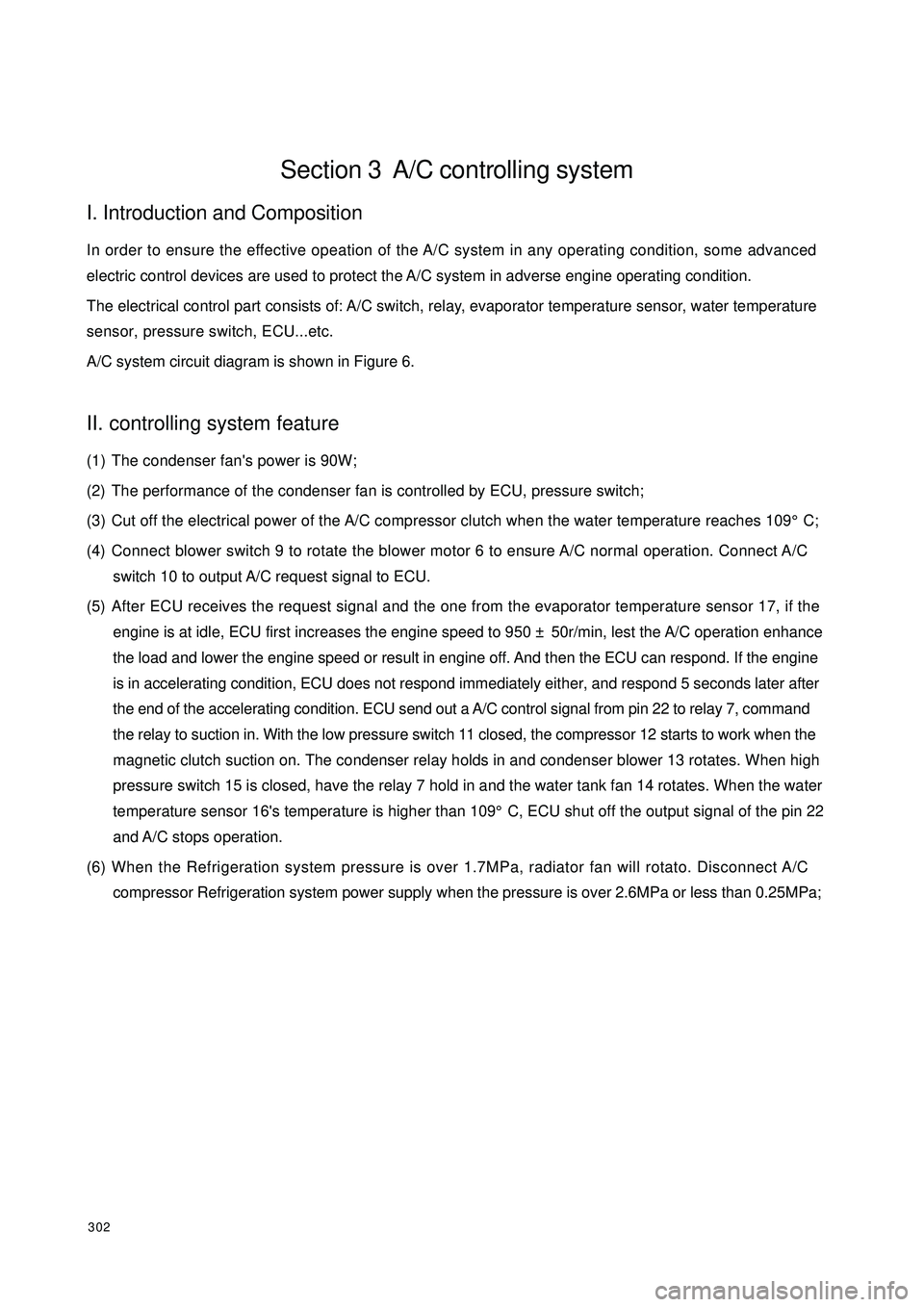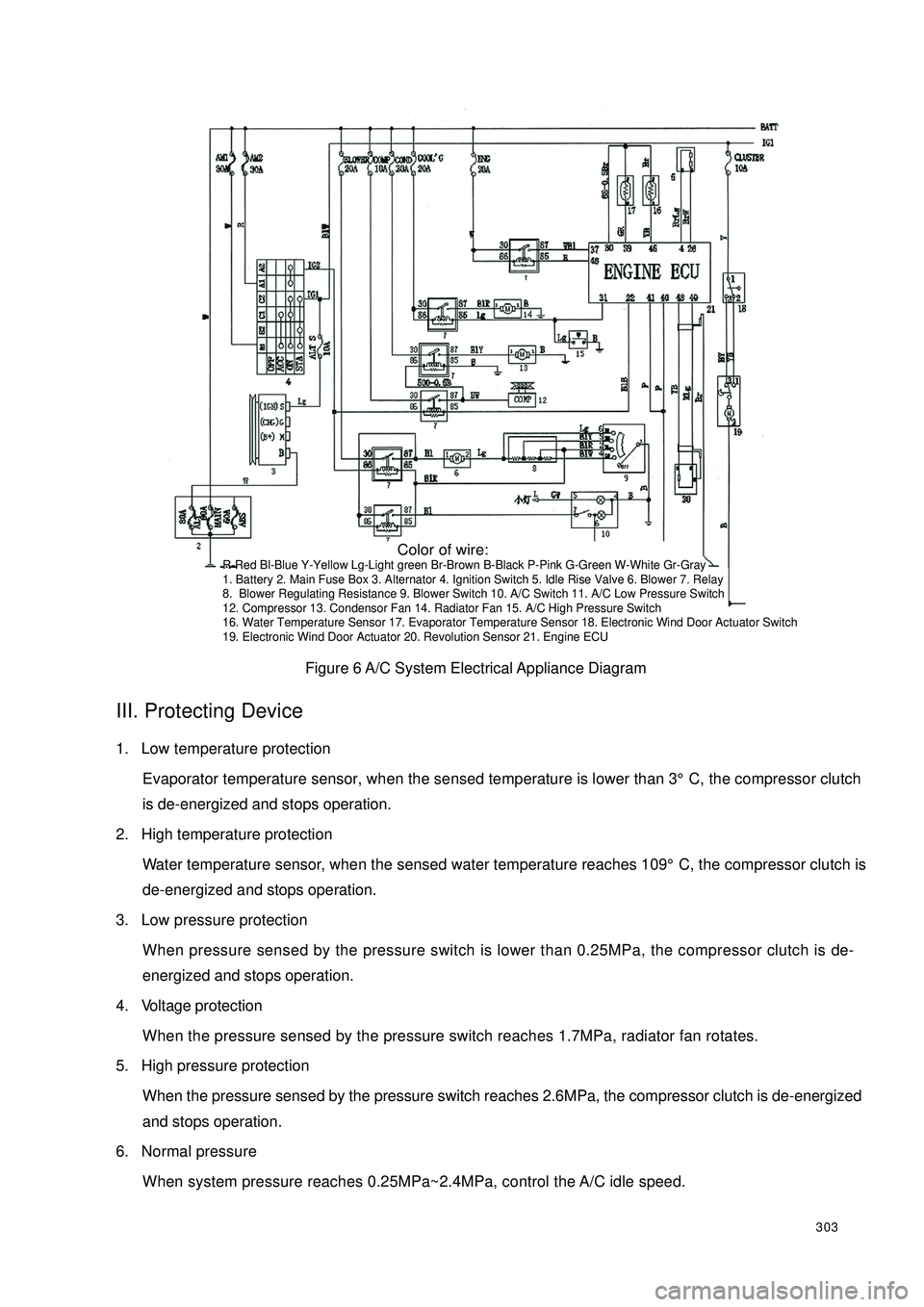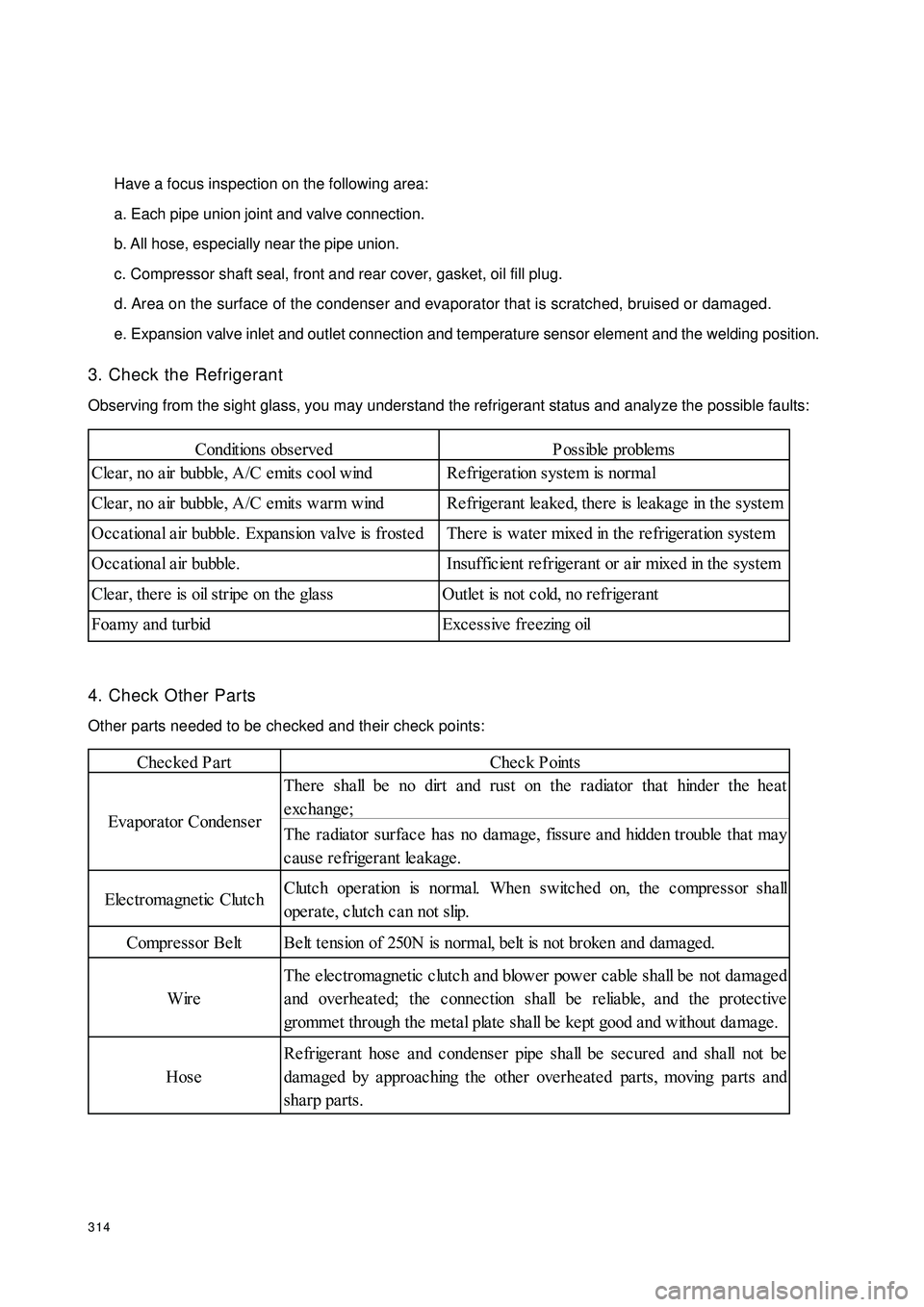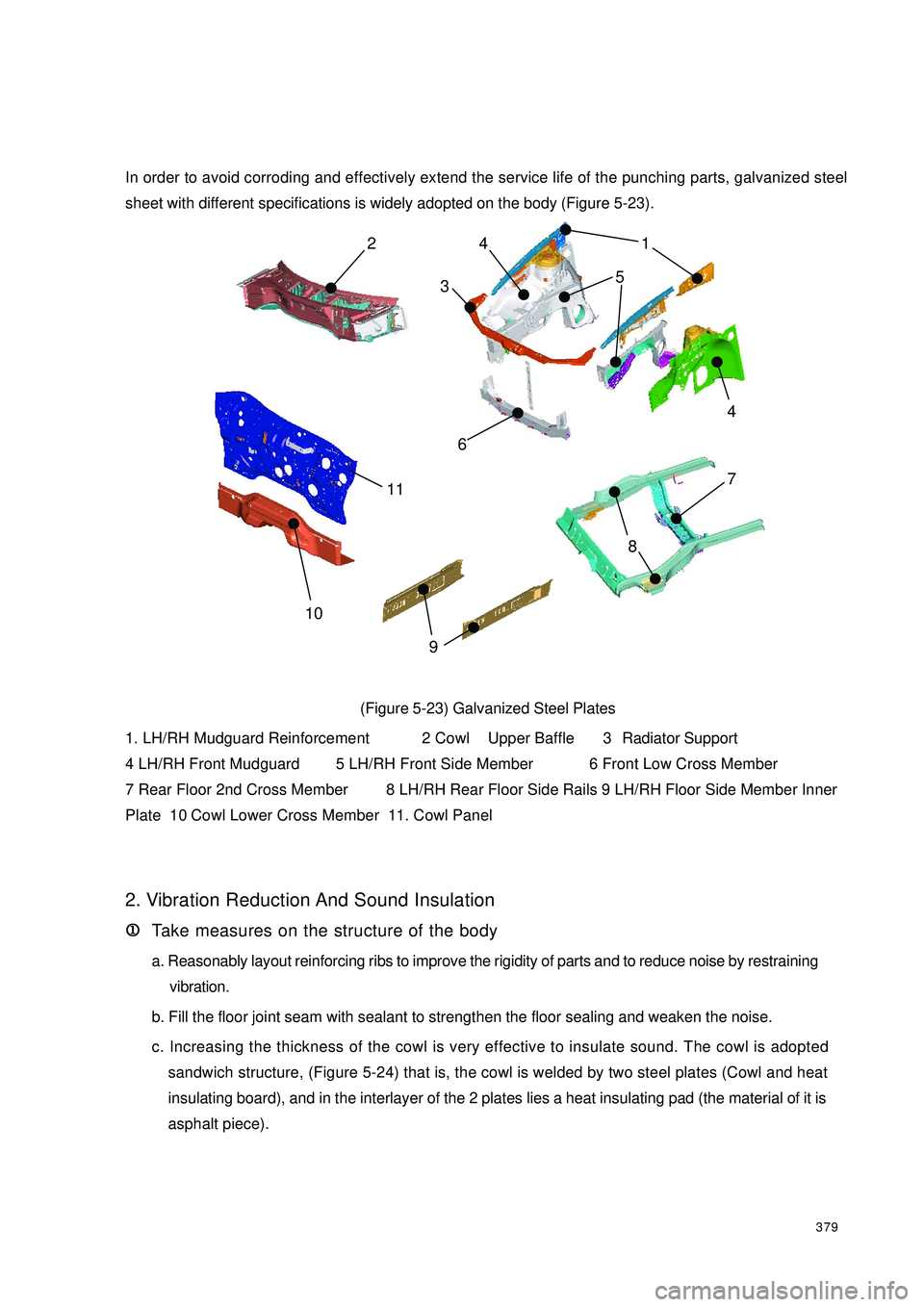radiator GEELY CK 2008 User Guide
[x] Cancel search | Manufacturer: GEELY, Model Year: 2008, Model line: CK, Model: GEELY CK 2008Pages: 392, PDF Size: 38.86 MB
Page 306 of 392

299Section 2 Heating SystemHeating system uses mixed temperature adjustment which controls both cold and hot air and is featured in
outstanding temperature adjustment performance. The cold and hot air can be completely mixed at each
outlet and achieve continuous temperature adjustment. The air duct arrangement on the instrument panel is
shown in Figure 2. The air flow channel system is shown in Figure 3.I. Heating System Parameter and StructureHeating system uses water heating structure which uses the engine coolant as the heat source, leads the the
coolant into the heating radiator installed in the vehicle compartment and has the interior or exterior air blow
across the radiator with the blower to increase its temperature. The system consists of the blower assembly,
heating control assembly and heater assembly.Figure 2 Heating Duct ArrangementInside and Outside Air Switch Door Outdoor AirIndoor AirDefoggerIntermidiate outletHeaterBlower MotorEvaporatorAir Mix DoorHeating RadiatorFigure 3 Air Flow Channel System Illustration
Page 307 of 392

3001. Heating System Parameter
Heating system radiating power, blower fan diameter, power dissipation and heater radiator dimension are
show in the table 2.
Table2
Heating System Parameter
2. Blower
Blower is located at the lower part of the goods
compartment. The door inside the blower case is con-
trolled by the servomotor. The exchange of the air in-
side and outside the door can be achieved by adjusting
the door to import the outdoor air and recirculate the
indoor air.
Blower motor uses Permenant magnet DC motor with multple blade fan. In addition, there are a set of
resistance on the blower which adjust the fan, called as adjusting resistor. Blower provides wind supply not
only to the heating radiator, but also to the evaporator in the refrigeration system.
3. A/C Control Mechanism
A/C control mechanism is located in the middle of the instrument panel. All adjustment except the A/C switch
and inside and outside circulation switch are made by rotating the control knob. The A/C control panel is
shown in Figure 4.
1Temperature adjustment control knob: control the mix ratio of the cold and hot air by adjusting the air mix
door, use the control knob to achieve continuous temperature adjustment.
2Outlet control knob: use 4 ranges, different types of air flow adjustment available.
3Inside and outside circulation switch: It can toggles between the introduction of outdoor air and recirculation
of the indoor air. (press the switch for inside circulation)
4Blower switch: when the plum blossom range is closed, the remaining four ranges are used to adjust the
air flow.
5A/C switch: as the switch of the refrigeration system, use press-button with built-in A/C indicator.Dissipation Power/W 4000
Air Flow/(m3/h)280
Power Consumption /W 180
Fan Diameter/mm 140
Overall Radiator Dimension 159.4mm×140mm×49mm Figure 4 A/C Control Panel
Page 308 of 392

301 4. Heater
Figure 5 Heater Door Control Diagram
The heater comprises the heater radiator (heat exchanger), the plastic case forming the air duct, connecting
rods adjusting different air ducts and the door. The two groups of combination doors in the heater case are
connected to the heating control mechanism by the cable. The first group is the two couple action doors
adjusting the air mix ratio that are located in the outlet and inlet each; the second group comprises 4 doors
controlling the air outlet vents, where the upper center one controls the front outlet vent, each of the upper
left and right sides controls a defogger outlet vent and lower foot outlet vent. Figure 5 shows the working
principle of temperature adjustment door. The d) , c) , e) , f) in the figure indicate the outlet air flow direction
as the result of the adjustment of the control knob in the heating control mechanism panel.Hot Wind LocationCold Wind LocationLinkageRadiator CoreRadiator CoreTemperature Adjustment
Door Working PrincipleFoot OutletTo Front OutletTo DefrosterRadiator CoreTo Front OutletRadiator CoreFoot OutletFoot OutletTo Defroster
Page 309 of 392

302Section 3 A/C controlling systemI. Introduction and CompositionIn order to ensure the effective opeation of the A/C system in any operating condition, some advanced
electric control devices are used to protect the A/C system in adverse engine operating condition.
The electrical control part consists of: A/C switch, relay, evaporator temperature sensor, water temperature
sensor, pressure switch, ECU...etc.
A/C system circuit diagram is shown in Figure 6.II. controlling system feature(1) The condenser fan's power is 90W;
(2) The performance of the condenser fan is controlled by ECU, pressure switch;
(3) Cut off the electrical power of the A/C compressor clutch when the water temperature reaches 109°C;
(4) Connect blower switch 9 to rotate the blower motor 6 to ensure A/C normal operation. Connect A/C
switch 10 to output A/C request signal to ECU.
(5) After ECU receives the request signal and the one from the evaporator temperature sensor 17, if the
engine is at idle, ECU first increases the engine speed to 950 ± 50r/min, lest the A/C operation enhance
the load and lower the engine speed or result in engine off. And then the ECU can respond. If the engine
is in accelerating condition, ECU does not respond immediately either, and respond 5 seconds later after
the end of the accelerating condition. ECU send out a A/C control signal from pin 22 to relay 7, command
the relay to suction in. With the low pressure switch 11 closed, the compressor 12 starts to work when the
magnetic clutch suction on. The condenser relay holds in and condenser blower 13 rotates. When high
pressure switch 15 is closed, have the relay 7 hold in and the water tank fan 14 rotates. When the water
temperature sensor 16's temperature is higher than 109°C, ECU shut off the output signal of the pin 22
and A/C stops operation.
(6) When the Refrigeration system pressure is over 1.7MPa, radiator fan will rotato. Disconnect A/C
compressor Refrigeration system power supply when the pressure is over 2.6MPa or less than 0.25MPa;
Page 310 of 392

303Figure 6 A/C System Electrical Appliance DiagramIII. Protecting Device1. Low temperature protection
Evaporator temperature sensor, when the sensed temperature is lower than 3°C, the compressor clutch
is de-energized and stops operation.
2. High temperature protection
Water temperature sensor, when the sensed water temperature reaches 109°C, the compressor clutch is
de-energized and stops operation.
3. Low pressure protection
When pressure sensed by the pressure switch is lower than 0.25MPa, the compressor clutch is de-
energized and stops operation.
4. Voltage protection
When the pressure sensed by the pressure switch reaches 1.7MPa, radiator fan rotates.
5. High pressure protection
When the pressure sensed by the pressure switch reaches 2.6MPa, the compressor clutch is de-energized
and stops operation.
6. Normal pressure
When system pressure reaches 0.25MPa~2.4MPa, control the A/C idle speed. Color of wire:R-Red Bl-Blue Y-Yellow Lg-Light green Br-Brown B-Black P-Pink G-Green W-White Gr-Gray
1. Battery 2. Main Fuse Box 3. Alternator 4. Ignition Switch 5. Idle Rise Valve 6. Blower 7. Relay
8. Blower Regulating Resistance 9. Blower Switch 10. A/C Switch 11. A/C Low Pressure Switch
12. Compressor 13. Condensor Fan 14. Radiator Fan 15. A/C High Pressure Switch
16. Water Temperature Sensor 17. Evaporator Temperature Sensor 18. Electronic Wind Door Actuator Switch
19. Electronic Wind Door Actuator 20. Revolution Sensor 21. Engine ECU
Page 317 of 392

3104. A/C Compressor Removal / Installation1. Disconnect the negative (--) terminal cable from the battery.
2. Drain the refrigerant from the system.
3. Detach the radiator.
4. Loose the drive belt and then remove the drive belt.Notice:•If anything moisture or any foreign matter enters into the Refrigeration system for circulation,
the cooling performance of the Refrigeration system will obviously deteriorate with abnormal
noise. Plug the port immediately after removing any cooling circulation component to prevent
anything moistur or any foreign matter from entering the circulation.5. Remove the compressor inlet and outlet pipe.
6. Removemagnetic clutch connector.
7. Remove the compressor.
8. The installation is in the reverse order of the removal.
9. Adjust the drive belt.
10. Check the Refrigeration system performance.5. The Condenser Removal / Installation1. Disconnect the negative (--) terminal cable from the battery.
2. Drain the refrigerant from the system.Notice:•If anything moisture or any foreign matter enters into the Refrigeration system for circulation,
the cooling performance of the Refrigeration system will obviously deteriorate with abnormal
noise. Plug the port immediately after removing any cooling circulation component to prevent
anything moistur or any foreign matter from entering the circulation.3. Remove the condenser inlet and outlet pipeline to prevent the compressor oil from splashing.
4. Remove condenser fan connector.
5. Remove the engine hood lock.
6. Remove the engine hood lock support brace.
7. Remove the condenser.
8. The installation is in the reverse order of the removal.
9. Check the Refrigeration system performance.The Condenser Installation Description:1. When installing the new condenser, it is recommended to fill certain SW-100 compressor oil into the
refrigerant circuit.Refill: (approximate)
20ml{20 cc }
Page 321 of 392

314Have a focus inspection on the following area:
a. Each pipe union joint and valve connection.
b. All hose, especially near the pipe union.
c. Compressor shaft seal, front and rear cover, gasket, oil fill plug.
d. Area on the surface of the condenser and evaporator that is scratched, bruised or damaged.
e. Expansion valve inlet and outlet connection and temperature sensor element and the welding position.
3. Check the Refrigerant
Observing from the sight glass, you may understand the refrigerant status and analyze the possible faults:
4. Check Other Parts
Other parts needed to be checked and their check points:Conditions obse rvedP ossible proble ms
Cle ar, no a ir bubble , A/C e mits c ool wind Re frige ra tion system is normal
Cle ar, no a ir bubble , A/C e mits warm wind Re frige ra nt le a ke d, the re is le aka ge in the syste m
Occ a tiona l a ir bubble . Expa nsion va lve is froste d There is wa te r mixe d in the re frigeration syste m
Occational air bubble. Insufficient refrigerant or air mixed in the system
Cle ar, the re is oil stripe on the gla ss Outle t is not c old, no refrige ra nt
Foamy and turbid Excessive freezing oilChecked PartCheck Points
The re sha ll be no dirt and rust on the radiator tha t hinde r the he at
exchange;
The ra dia tor surfa ce ha s no da mage , fissure a nd hidde n trouble tha t ma y
cause refrigerant leakage.
Elec tromagne tic Clutc hClutc h ope ration is norma l. Whe n switche d on, the c ompre ssor sha ll
operate, clutch can not slip.
Compre ssor Be lt Be lt te nsion of 250N is normal, belt is not broke n and dama ged.
WireThe electromagnetic clutch and blower power cable shall be not damaged
and overheated; the connection shall be reliable, and the protective
gromme t through the me tal plate sha ll be ke pt good a nd without da ma ge .
HoseRefrigerant hose and condenser pipe shall be secured and shall not be
dama ged by a pproac hing the othe r ove rhe ate d pa rts, moving pa rts a nd
sha rp parts. Eva pora tor Conde nse r
Page 367 of 392

360(I) Front Sheet Metal, Cowl PartsThe main function of the front sheet metal and the cowl parts is forming an engine compartment to supply the
engine and accessories with a protective cover and to absorb the most energy when vehicle encounters
frontal impaction, protecting mud from being splashed by the front wheels, and meeting the requirements of
body design in appearance. It is mainly composed of front cross member assembly, LH/RH front mud guard
and front side member assembly, engine hood front support plate assembly, hood lock bracket assembly,
cowl assembly, cowl upper assembly.
1. Front Cross Member Assembly
The front cross member assembly is mainly composed of the front cross member welding sub-assembly,
front cross member bottom plate assembly, LH/RH side member end plate by welding them together, and its
dismantle diagram as shown in the Figure 5-2.
2. Lh/Rh Front Mudguard And Front Side Member Assembly
LH/RH front mud guard and front side member assembly is mainly composed of LH/RH front mudguards
and LH/RH side members by welding them together.
It is mainly used to mount some mounting brackets such as the engine LH/RH side suspension bracket, LH/
RH front suspension shock absorber bracket, etc. and to mount the LH/RH front fenders.
3. Engine Hood Front Support Plate Assembly
Engine hood front support plate is mainly composed of LH/RH headlamp mounting bracket assembly, hood
front support plate sub-assembly, and LH/RH front support plate reinforcement, by welding them together.
Engine hood front support plate assembly is used to mount radiator, engine hood lock, radiator grille, front
bumper, and headlamp.
4. Engine Hood Lock Bracket Assembly
Engine hood lock bracket assembly is used to mount the engine hood lock, also to strengthen the intensity and
rigidity of the front body by connecting the engine hood front support plate and front cross member.
5. Cowl Assembly
Cowl assembly is mainly composed of cowl inner and outer plate assembly and cowl lower cross member, by
welding them together.
Cowl assembly and front floor, LH/RH front mud guard (LH/RH front pillar), cowl upper baffle is welded
together, which forms a framework with great torsional strength. It generates great resistance to lateral
impact and rolled deformation.
Cowl inner and outer plate assembly is sandwich structure. 3mm of asphalt plate lies in the interlayer, which
is to cut off the noise and heat generated from the engine.
Page 386 of 392

379In order to avoid corroding and effectively extend the service life of the punching parts, galvanized steel
sheet with different specifications is widely adopted on the body (Figure 5-23).
(Figure 5-23) Galvanized Steel Plates
1. LH/RH Mudguard Reinforcement 2 Cowl Upper Baffle 3 Radiator Support
4 LH/RH Front Mudguard 5 LH/RH Front Side Member 6 Front Low Cross Member
7 Rear Floor 2nd Cross Member 8 LH/RH Rear Floor Side Rails 9 LH/RH Floor Side Member Inner
Plate 10 Cowl Lower Cross Member 11. Cowl Panel
2. Vibration Reduction And Sound Insulation
1 11 1
1Take measures on the structure of the body
a. Reasonably layout reinforcing ribs to improve the rigidity of parts and to reduce noise by restraining
vibration.
b. Fill the floor joint seam with sealant to strengthen the floor sealing and weaken the noise.
c. Increasing the thickness of the cowl is very effective to insulate sound. The cowl is adopted
sandwich structure, (Figure 5-24) that is, the cowl is welded by two steel plates (Cowl and heat
insulating board), and in the interlayer of the 2 plates lies a heat insulating pad (the material of it is
asphalt piece).87 5
4 4 21
9 10 63
11